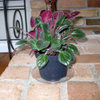Propagating Streps
frankiokc
17 years ago
I would like some advice on propagating streps from leaves. I haven't had success with it in the past due to rotting of the leaves. Should I keep the leaf totally enclosed or is that causing too much moisture that leads to rotting?
I have a leaf down right now in the soilless mix I use for mature plants. The leaf isn't turgid, but isn't showing signs of rotting, yet. The wilted appearance of the leaf doesn't seem right, though. Shouldn't it still stay somewhat turgid while rooting?
Franki in Hot Springs, AR

robitaillenancy1
Motezuma
Related Professionals
Beachwood Landscape Architects & Landscape Designers · Belmont Landscape Architects & Landscape Designers · Signal Hill Landscape Architects & Landscape Designers · Norwood Landscape Contractors · Woburn Landscape Contractors · Aberdeen Landscape Contractors · Fort Atkinson Landscape Contractors · Paso Robles Landscape Contractors · Rockland Landscape Contractors · Kingsburg Landscape Contractors · Casselberry Landscape Contractors · Columbus Siding & Exteriors · Guilford Siding & Exteriors · Honolulu Siding & Exteriors · Ramona Siding & Exteriorsifraser25
jon_d
swiss_1
frankiokcOriginal Author